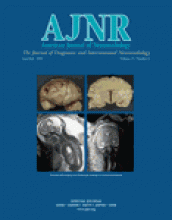Research ArticleBRAIN
Comparison of CT and Three MR Sequences for Detecting and Categorizing Early (48 Hours) Hemorrhagic Transformation inHyperacute Ischemic Stroke
Marie-Cécile Arnould, Cécile B. Grandin, André Peeters, Guy Cosnard and Thierry P. Duprez
American Journal of Neuroradiology June 2004, 25 (6) 939-944;
Marie-Cécile Arnould
Cécile B. Grandin
André Peeters
Guy Cosnard

References
- ↵The NINDS rt-PA Stroke Study Group. Tissue plasminogen activator for acute ischemic stroke. N Eng J Med 1995;333:1581–1587
- ↵Hacke W, Kaste M, Fieschi C, et al. Intravenous thrombolysis with recombinant tissue plasminogen activator for acute hemispheric stroke: the European Cooperative Acute Stroke Study (ECASS). JAMA 1995;274:1017–1025
- ↵Hacke W, Kaste M, Fieschi C, et al. Randomised double-blind placebo-controlled trial of thrombolytic therapy with intravenous alteplase in acute ischaemic stroke (ECASS II). Lancet 1998;352:1245–1251
- ↵Liu M, Counsell C, Zhao XL, Wardlaw J. Fibrinogen depleting agents for acute ischaemic stroke. In: Cochrane Library Issue 2, Chichester UK: John Wiley and Sons, Ltd.,2004
- ↵Fisher CM, Adams RD. Observation on brain embolism with special reference to the mechanism of hemorrhagic infarction. J Neuropathol Exp Neurol 1951;10:92–94
- ↵Jorgensen L, Torvik A. Ischemic cerebrovascular disease in an autopsy series. Part 2. Prevalence, location, pathogenesis, and clinical course of cerebral infarcts. J Neurol Sci 1969;9:285–320
- ↵Lodder J, Krijne-Kubat B, Broekman J. Cerebral hemorrhagic infarctions at autopsy: cardiac embolic cause and the relationship to the cause of death. Stroke 1986;17:626–629
- ↵Patel MR, Edelman RR, Warach S. Detection of hyperacute primary intraparenchymal hemorrhage by magnetic resonance imaging. Stroke 1996;27:2321–2324
- ↵Linfante I, Linas RH, Caplan LR, Warach S. MRI features of intracerebral hemorrhage within 2 hours from symptom onset. Stroke 1999;30:2236–2267
- ↵Schellinger PD, Jansen O, Fiebach JB, et al. A standardized MRI stroke protocol: comparison with CT in hyperacute intracerebral hemorrhage. Stroke 1999;30:765–768
- ↵
- ↵von Kummer R. MRI: the new gold standard for detecting brain hemorrhage? Stroke 2002;33:1748–1749
- ↵
- ↵New PF, Aronow S. Attenuation measurements of whole blood and blood fractions in computed tomography. Radiology 1976;121:635–640
- ↵Pessin MS, Del Zoppo GJ, Estol CJ. Thrombolytic agents in the treatment of stroke. Clin Neuropharmacol 1990;13:271–289
- ↵Fischer CM, Adams RD. Observations on brain embolism with special reference to hemorrhagic infarction. In: Furlan AJ, ed. The heart and stroke. New-York: Springer-Verlag;1987 :17–36
- ↵Hayman LA, Tuber KH, Ford JJ, Bryan RN. Mechanisms of MR signal alteration by acute intracrebral blood: old concepts and new theories. AJNR Am J Neuroradiol 1991;12:899–907
- ↵Berger C, Fiorelli M, Steiner T, et al. Hemorrhagic transformation of ischemic brain tissue: asymptomatic or symptomatic? Stroke 2001;32:1330
- Fiorelli M, Bastianello S, von Kummer R, et al. Hemorrhagic transformation within 36 hours of a cerebral infarct. Stroke 1999;30:2280–2284
- Molina CA, Alvarez-Sabin J, Montaner J, et al. Thrombolysis-related hemorrhagic infarction: a marker of early reperfusion, reduced infarct size, and improved outcome in patients with proximal middle cerebral artery occlusion. Stroke 2002;33:1551–1556
- ↵von Kummer R. Brain hemorrhage after thrombolysis: good or bad? Stroke 2002;33:1446–1447
- ↵Kidwell CS, Saver JL, Carneado J, et al. Predictors of hemorrhagic transformation in patients receiving intra-arterial thrombolysis. Stroke 2002;33:717–724
- Kidwell CS, Saver JL, Villablanca JP, et al. Magnetic resonance imaging detection of microbleeds before thrombolysis: an emerging application. Stroke 2002;33:95–98
- ↵Nighoghossian N, Hermier M, Adeleine P, et al. Old microbleeds are a potential risk factor for cerebral bleeding after ischemic stroke: a gradient-echo T2*-weighted brain MRI study. Stroke 2002;33:735–742
- ↵Coutts S, Frayne R, Sevick R, Demchuk A. Microbleeding on MRI as a marker for hemorrhage after stroke thrombolysis. Stroke 2002;33:1457–1458
In this issue
Advertisement
Marie-Cécile Arnould, Cécile B. Grandin, André Peeters, Guy Cosnard, Thierry P. Duprez
Comparison of CT and Three MR Sequences for Detecting and Categorizing Early (48 Hours) Hemorrhagic Transformation inHyperacute Ischemic Stroke
American Journal of Neuroradiology Jun 2004, 25 (6) 939-944;
0 Responses
Jump to section
Related Articles
- No related articles found.
Cited By...
- Determinants and Clinical Relevance of Iodine Contrast Extravasation after Endovascular Thrombectomy: A Dual-Energy CT Study
- Hemorrhage rates in patients with acute ischemic stroke treated with intravenous alteplase and thrombectomy versus thrombectomy alone
- Type of intracranial hemorrhage after endovascular stroke treatment: association with functional outcome
- Functional Outcome, Recanalization, and Hemorrhage Rates After Large Vessel Occlusion Stroke Treated With Tenecteplase Before Thrombectomy
- Association of initial imaging modality and futile recanalization after thrombectomy
- Dual energy CT after stroke thrombectomy alters assessment of hemorrhagic complications
- Agreement between core laboratory and study investigators for imaging scores in a thrombectomy trial
- Focal Low and Global High Permeability Predict the Possibility, Risk, and Location of Hemorrhagic Transformation following Intra-Arterial Thrombolysis Therapy in Acute Stroke
- Brain Edema Predicts Outcome After Nonlacunar Ischemic Stroke
- Suspicious Neuroimaging Pattern of Thrombotic Microangiopathy
- Substantial Observer Variability in the Differentiation Between Primary Intracerebral Hemorrhage and Hemorrhagic Transformation of Infarction on CT Brain Imaging
- Haemorrhagic transformation in acute ischaemic stroke following thrombolysis therapy: classification, pathogenesis and risk factors
- Angiogenesis Detected After Embolic Stroke in Rat Brain Using Magnetic Resonance T2*WI
- Asymptomatic Hemorrhage After Thrombolysis May Not Be Benign: Prognosis by Hemorrhage Type in the Canadian Alteplase for Stroke Effectiveness Study Registry
- Imaging
This article has not yet been cited by articles in journals that are participating in Crossref Cited-by Linking.
More in this TOC Section
Similar Articles
Advertisement











